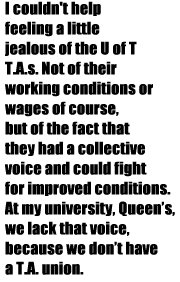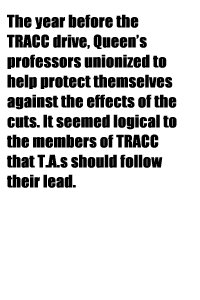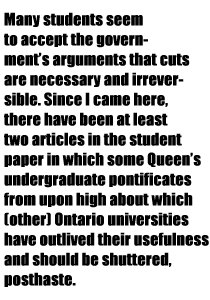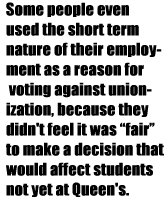

Sarah Riegel
2. From my vantage point -- three hours to the east of U of T, where I am a grad student and T.A. at another pre-eminent Canadian university -- I couldn't help feeling a little jealous of the U of T T.A.s. Not of their working conditions or wages of course, but of the fact that they had a collective voice and could fight for improved conditions. At my university, Queen’s, we lack that voice, because we don’t have a T.A. union.
3. This isn’t for lack of trying. Successive generations of Queen’s T.A.s have formed organizing drives to attempt to win for us the same protections held by T.A.s at most other universities in Ontario. Most recently, in the 1997-98 school year, the Teaching and Research Assistant Certification Campaign (TRACC) waged an unsuccessful battle to certify as a local of the Canadian Union of Public Employees (CUPE). I joined that campaign in my first weeks at Queen's, a fresh-faced young Ph.D. student hoping to reap the benefits of a union contract before I graduated. Now that I am resigned to the fact that there will not be a T.A. union at Queen’s before I leave, it's worth looking back on TRACC to figure out what went wrong.
4. Most people who are familiar with Queen’s would probably point to the university’s conservative reputation as a crucial factor contributing to its unreceptive attitude to T.A. unions. Certainly, they wouldn't be far off-base on this. If U of T is Canada's top research university, Queen’s is the finishing school for the young anglo haute bourgeoisie. An air of privilege and tradition hangs among the limestone buildings of the campus, from the unpronounceable Gaelic of the school song to the “Kill McGill” t-shirts bearing the memorable phrase: “As a matter of fact, going to Queen’s does make me better than you.” Since I came here, there have been at least two articles in the student paper in which some Queen’s undergraduate pontificates from upon high about which (other) Ontario universities have outlived their usefulness and should be shuttered, posthaste.
5. The effects of this conservative climate on organizing potential can be exaggerated , however. There were good reasons for feeling that TRACC had a good chance for success. After all, no matter how much undergrads at Queen's may adopt the trappings of an elite private college, this is still a primarily public institution and, as such, it has been subject to the same government funding cuts as “lesser” universities. This manifests itself not only in growing tuition and shrinking paychecks for T.A.s, but also in a failure to replace retiring faculty and a library system so cash-strapped that it has been ranked among the worst at a research institution in North America. The year before the TRACC drive, Queen’s professors unionized to help protect themselves against the effects of the cuts. It seemed logical to the members of TRACC that T.A.s should follow their lead.
6. Unfortunately, the T.A. population at large did not share our feelings. When the certification vote was held on April 16, 1998, 324 voted against, and only 223 voted for unionization (there were also four spoiled ballots, 131 excluded for ineligibility, and twenty whose eligibility were disputed). While numerous contingent factors, from the (unavoidable) timing of the vote during exams to the heavy rainstorm the day of the vote, played a role in the defeat, what seems particularly relevant in hindsight is the way the drive was shaped and constrained by the politics of neo-liberalism. While Queen’s students may not have been especially happy with their working conditions, many of them seemed to have accepted the Thatcherite nostrum of “There Is No Alternative” (TINA)
7. While there were sporadic protests against the constant cuts and financial assaults on the university system during the 1990s, students’ response seems to have been the development of a zero-sum mentality about university finances. Many students seem to accept the government’s arguments that cuts are necessary and irreversible. The politics of the university then revolves around how to divide up a declining pool of resources, where any increased benefit to one group is seen as harming another group.
8. The “No” side in the union campaign used this sentiment to their benefit. A grad student in Economics wrote a series of letters to the editor of the campus newspaper arguing that any gains in T.A. wages or benefits growing out of unionization would inevitably lead to fewer journals in the library and even less heat in the buildings. T.A.s were presented as a special-interest group whose greedy demands would harm the “average student.”
9. Where this attitude was most damaging to TRACC was in the sciences. Both the experience of organizers across North America and opinion surveys have shown time and time again that those in the “hard” sciences are less likely to support T.A. or faculty unions than their colleagues in the arts and social sciences. TRACC was no different, with most of the organizing committee coming from the arts, particularly History and English. Science departments generally were much more difficult venues in which to sign union cards, and they were the seat of a well-orchestrated campaign the week of the election to pull the “No” vote.
10. One of the factors that drove opposition to TRACC in the sciences was a fear of equalization with the arts, where grad students are generally less well-funded. In some cases this was driven by disciplinary snobbery, as in the case of the science student who told a TRACC organizer that he was better than an arts student and did not want to be part of the same union. Such a blatant expression of superiority was more isolated, however, than the widespread zero-sum mentality pervading the university. For many science students, the prospect of a T.A. union meant demands for equalization, which they saw as being achievable only through a reduction of their income. The possibility that incomes could be levelled upwards by raising the arts students was unthinkable in Harris’ Ontario. In fact, there was little a T.A. union could do to equalize incomes across the university, because the greatest gap is due not to the T.A. employment part of the income, but rather to scholarships and grants, which are outside a union's purview. Nonetheless, the climate of the late 90s was such that students could be easily frightened into accepting the status quo.
11. In addition, the temporary nature of T.A.ships led many students to adopt a short-term mentality which precluded attempts to improve working conditions. Many T.A.s responded to organizers by saying that their conditions weren’t so bad at Queen’s, and when reminded that without a contract, those conditions could be changed arbitrarily, they replied that they would be gone anyway. Some people even used the short term nature of their employment as a reason for voting against unionization, because they didn't feel it was “fair” to make a decision that would affect students not yet at Queen's. However democratic these sentiments may appear, their effect was to paralyze any changes. After all, choosing to maintain the status quo is as much a decision as choosing to unionize.
12. These sentiments among the T.A. population at large hampered the ability of TRACC to put forth a strong positive message about unionization. We refrained from putting forth specific demands or bargaining items that a union would pursue. This was partly intended to avoid a charge of unfair labor practices, but in large part it was due to a reluctance to seriously confront the attitudes described above. We were afraid to offend people but the inoffensive campaign that followed also failed to inspire.
13. In this way, we in effect ceded the direction of the campaign to the “No” side. When they raised fears that a union’s pay hikes would reduce resources for the “average student,” our response was to assure people that the union drive wasn’t about pay. This may have assuaged some fears generated by “No” side scare tactics, but what did it say to the T.A.s who damn well wanted a pay raise? The much more confrontational question of why T.A.s should be the ones to sacrifice their interests was not asked, publicly at least.
14. TRACC went out of its way to stress the democratic nature of CUPE. We felt that grad students, as educated professionals, would recoil from the prospect of “big labor” coming in and telling them how their jobs should work. Our stock answer to the question of what a union would do for T.A.s was to respond that the content of future collective negotiations would be up to the membership. In this way we avoided getting bogged down in debates about what the university could afford, but we ran smack into the problem of the short-term mentality among students. For people not necessarily ideologically committed to unionism, instrumental concerns will win the day. In fact, by far our most successful piece of campaign literature was a comparison sheet showing conditions reported by Queen's T.A.s next to excerpts from T.A. contracts at other CUPE universities. Queen’s T.A.s were looking for some reason to believe that a union would make real, tangible improvements in their working conditions. When all we offered them were vague platitudes about democracy, it is hardly surprising they voted no.
15. For a T.A. drive to succeed in the future at Queen’s, it has to offer
a positive agenda. This doesn’t mean making promises that can’t be
kept, but rather basing the campaign in specific issues T.A.s want addressed.
There are once again reasons to feel that a drive could be successful,
that the TINA attitude of the 1990s is wearing thin. Fifteen hundred
Queen's students turned out for a recent Canadian Federation of Students
Day of Action to protest rising tuition and reduced grants. This
was the second-largest protest in the country for the Day of Action, and
it came over the concerted opposition of the undergraduate student government
and in spite of a bitterly cold temperature. There is hope yet that
Queen’s T.A.s will find their voice.
Selected bibliography
Rogow, Robert and Daniel R. Birch. “Teaching Assistant Unionization:
Origins and Implications.” Canadian Journal of Higher Education.
XIV:1, 1984. 14-16.
Villa, Jennifer and Albert Blum. “Collective Bargaining in Higher Education: Prospects for Faculty Unions.” Journal of Collective Negotiations in the Public Sector. 25 (2), 1996. 162.
Wagar, Terry and Marie Chisholm. “Faculty Attitudes Toward Union Membership and Strike Action: Evidence from two Eastern Canadian Universities.” Journal of Collective Negotiations in the Public Sector. 24 (4), 1995. 333-34.
On general ideological distinctions between arts and sciences, see:
Lipset, S.M. and Everett Carll Ladd, Jr. The Divided Academy.
New York: McGraw-Hill, 1975. 68-75.
Sarah Riegel, Queen’s University
    |